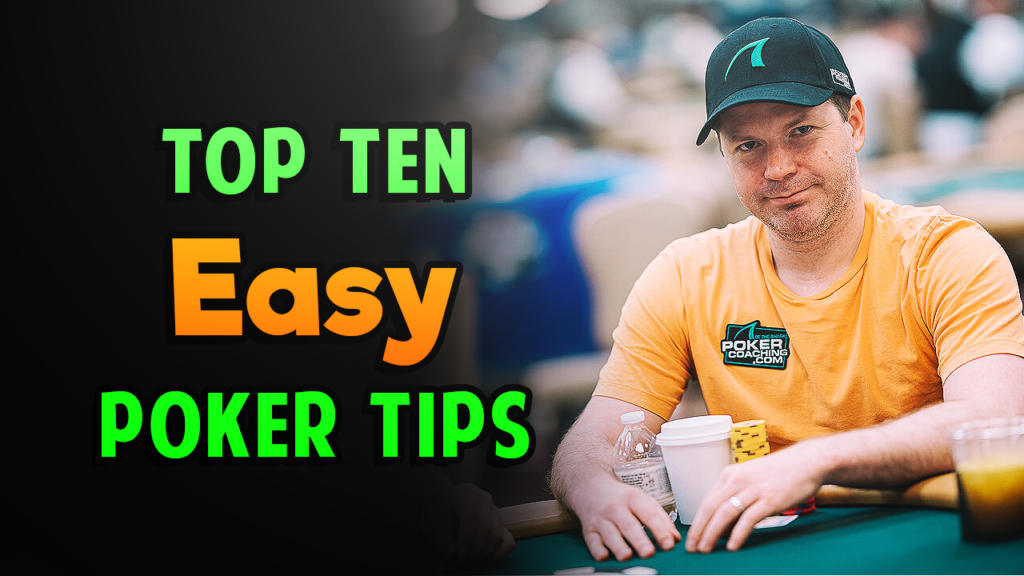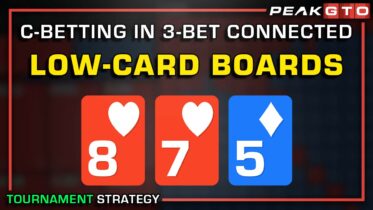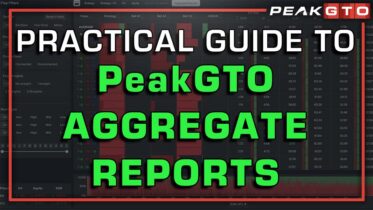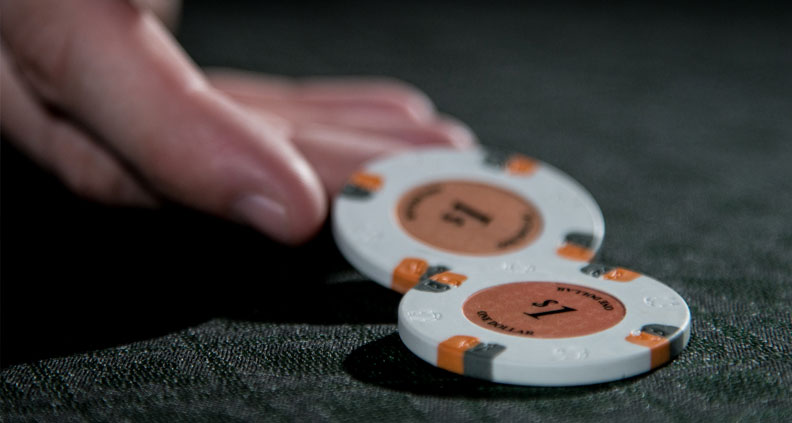In the modern era of poker, it is quite common to come across poker players who live and die by Game Theory Optimal (GTO) poker strategies. GTO poker is certainly worth studying if you want to play the best in the world, but how well does it translate to low stakes poker tournaments and cash games? Remember: if your opponents are not playing a GTO strategy, a lot of GTO principals go out the window. While that’s all well and good, how do we know when it is the proper time to deviate from GTO? In this article, I will share a number of hands that illustrate optimal spots to not play a GTO poker strategy.
Adjust To Player Tendencies And Types Instead Of Playing GTO
Deviating From A GTO Strategy When Facing Tight, Nitty Poker Players
This hand shows an adjustment many successful mid-stakes players are capable of making.
With 50 big blinds in the early stages of a large field poker tournament, a nitty player in the lojack raises and it folds around to you in the big blind holding A♠-7♣. You call making it heads-up heading to the flop.
The flop comes Q♠-7♦-4♣ giving you second pair. You check-call the preflop aggressor’s small continuation bet.
The turn is the 5♥, you check and your opponent sizes up with a 3/4 pot bet. According to a GTO solver, folding here would be incredibly tight, but facing a nitty opponent this is a good spot to deviate from GTO and exploitatively fold.
When a turn card favors you, but a nit continues betting, the vast majority of the time they have a good hand they will continue betting with. Assessing the board, not only are there few bluffs your opponent would continue betting with, but there are also few river cards where you would be comfortable calling another bet. Remember: nits do not bluff enough. If he happens to be firing with A-K, god bless him, but more often than not such players are betting with hands that beat you.
If you are facing a capable opponent, call and stick around. Although this is not a fold that you should be making against population, when you recognize an opponent’s tendencies be willing to deviate from GTO to make exploitative folds.
Adjust Preflop GTO Ranges To Avoid Punting To Nitty Players
This hand may be the most important one we cover in this article.
In the early stages of a poker tournament, it folds to you in the cutoff with 50 big blinds. You raise holding 9♠-9♥, and get three-bet by the player on the button. Despite your decent stack size, GTO will tell you that this is a shove. While it may seem insane to risk 50 big blinds with pocket nines, if you are facing proficient players who are capable of three-bet bluffing a wide range, this is a great spot to either flip for stacks or scoop a bunch of dead money preflop when they fold.
While ripping here is optimal facing a good poker player, if the player on the button is a nit the correct play differs. Facing a nit, going all-in would be out of the question, in fact it would be insane!
Most nits, if they three-bet bluff at all preflop, only do so with ⅓ of the hands they should be three-bet bluffing with. Instead of taking a risky line against a nit, you are better off calling and playing passively postflop. While you are not playing to purely set mine with your pocket nines, facing a tight nit play your hand more cautiously than you would facing a capable player.
Considering Your Skill Edge When Making Preflop Decisions
In this hand, a huge whale in the lojack raises and it folds to you on the button holding 8♠7♦ (100 big blinds effective). So far in this tournament, you have seen the lojack play a number of hands, and can already tell they are terrible. Considering the fact the lojacks sucks and both the blinds happen to be passive players, you call with your unsuited connectors.
This serves as an example of how GTO solvers fail to account for an important variable: player talent. GTO does not know the difference between a fish and Phil Ivey, making it critical you recognize when you have an edge and should move away from GTO. If you know you have a skill edge when facing another player, look for opportunities to play heads-up with them even if it is not solver approved.
Facing Well-Studied Poker Players
The next hand we will dissect covers a common flop spot that many good poker players may overlook and play the same way every time.
With 100 big blinds in the early stages of a poker tournament, it folds around to you on the button and you raise holding Q♠-10♣. Only the big blind calls.
The flop comes 10♥-6♣-4♦ and your opponent checks.
A lot of well-studied poker players will continuation bet on this flop nearly 100% of the time. While making a small continuation bet with top pair is not a bad play, doing it every time is not an ideal strategy. Although it may seem very passive, not only is this a spot worth checking back, but you should check nearly half the time.
When you have top pair with an overcard serving as a weak kicker, you are in an optimal spot to check back. It may seem like you are giving up equity with top pair, but by holding an overcard you help block possible turn cards that can give your opponent a better pair.
Considering your opponent’s tendencies when assessing whether to check or bet, you are much better off checking against competent opponents and betting against fishy ones. When you bet against a competent opponent, they are capable of executing check-raises and making a straightforward spot much more difficult to navigate. By checking, you avoid a potentially nasty spot while not giving up too much equity. If you are facing a fishy opponent, bet your top pair on the flop and target any worse pairs they may have picked up. You can’t expect a fishy recreational to create action, and even if they did it would be cause for concern!

Crush cash games and poker tournaments with Jonathan Little’s Top Ten Poker Tips!
Barrelling Too Aggressively Against Calling Stations
You are in the first level of a WSOP poker tournament with a deep stack of 200 big blinds. The lojack raises, drawing calls from the cutoff, the big blind, and you in the small blind holding 5♠4♠.
The flop comes K♠-8♥-4♣. After you and the big blind check, the preflop aggressor makes a bet for slightly more than half pot. After the cutoff folds, you have a perfectly scripted check-raise bluff spot. Despite the big blind still being in the hand, with bottom pair and runner-runner potential you can profitably check-raise bluff and potentially induce a fold from the lojack.
You check-raise, and only the lojack calls making it heads-up.
The turn card is the 3♦, essentially a brick card for you. While you can fire the turn and river in hopes of spiking an out or getting a bluff through, consider the type of player the lojack is. If they are the kind of player who won’t fold a king, continuing to follow GTO and triple barreling could be a major punt!
When reviewing hand histories, I’ll see skilled poker players continue firing in similar spots despite the fact it is in their best interest to give up. Facing opponents who have the tendency to be calling stations, you would much rather give up when you fail to get additional equity on the turn. Giving up on bluffs may hurt sometimes, but you would much rather conserve your chips than dump them off unnecessarily.
Common Spots Where You Should Not Play A GTO Poker Strategy
Ignoring GTO When Playing From The Blinds
Let’s consider another preflop spot, but from the blinds.
It folds to you in the small blind, and you have K♠-10♠ with a passive nit to your left. Any experienced poker player who frequently studies GTO knows that strategies can get complex when playing from the blinds. Some hands you limp, some hands you raise, with all sorts of mixing in between. While this is all well and good against other skilled poker players, facing a passive nit there is no need to get fancy. It’s simple: facing passive nits from the blinds, ignore GTO limping ranges and exploit by raising with good hands. When playing against weak opponents, there is no need to play an overly refined strategy. Play a more implementable strategy, even if it goes against GTO.
Look For Preflop Spots To Scoop Dead Money Pots (WHEN To Play GTO)
The following hand may be one some players find to be an “easy” spot, but it is one I often see my students miss when playing poker tournaments. Unlike other hands featured in this article, this is a preflop spot where you should be playing GTO, despite it being a spot that is often overlooked.
With 50 big blinds in the early-middle stages of a poker tournament, the lojack raises and draws calls from both the cutoff and the button. Holding Q♥-J♥ in the small blind, you have a decision to make. While many poker players simply flat to see the flop, they fail to seize an opportunity to scoop a lot of dead money. Even though you have 50 big blinds, this is an optimal spot to move all-in. Especially at the low and mid-stakes, this shove prints a lot of equity. While it may seem crazy to shove with this stack size, consider a few things…
Out of all of the opponents that remain in the hand, the one you have to worry about the most is the initial raiser. While you may be behind some of the hands in their range, you are also alive or flipping against others like A-K, pocket tens, and pocket nines. There are also a wide variety of hands that are ahead of you that you can force to fold, like A-Q offsuit.
Both of the preflop callers have incredibly capped ranges, making them prime targets to go after with a preflop shove. Unless they are incredibly tricky limpers, both of these players will fold the vast majority of the time, especially if the initial raiser decides to call.
What makes this shove so effective is that the vast majority of the player population does not have this play in their game. Most players witnessing this shove will assume you have pocket jacks or better, and will willingly forfeit the pot folding hands that may have you beat. This same shove can be made with J-10 suited, as well as low-suited aces.
Skilled poker players who are profitable at the low to mid stakes may be wary of this shove, citing how they are sacrificing the edge they have against the field. While you may be the best player at a given poker table, that does not change the fact that this is a +EV shove that has low variance overall. Roughly, all three opponents will fold 80% of the time. Rather than call or squeeze to play this spot out of position, you can take advantage of a GTO-approved spot that rewards you with lots of dead money.
Common Cash Game Spots Where GTO Does Not Apply
It has never been more fun to play live cash games. With the growing popularity of live streamed productions like Hustler Casino Live, no-limit hold’em cash game variations like the Stand-Up Game create unique spots for players to master. While such game variations are fun and help create action at the poker table, they also create spots that are not “solved” with GTO. It would certainly be helpful to know the optimal play to make when playing the Stand Up Game or when there are more than two blinds in play, but such “solves” are not currently available to players.
When studying poker using GTO solvers, it is important to consider what the solver assumes when providing you with outputs. Being based around GTO, solvers assume the opponents you are facing are also adhering to a GTO strategy. If you regularly play low stakes poker tournaments and cash games, you know a lot of the player population does not play a GTO strategy. The farther you go down the decision tree, the more GTO decisions the solver assumes your opponent has made. If your opponents make plays that greatly deviate from GTO, the best way to counter is by knowing when to deviate from GTO yourself.
Playing Hands That GTO “Mixes”
Pure Folding With Hands That Mix
Let’s consider a spot where you are dealt what many poker players consider their least favorite hand: pocket jacks.
Early in a poker tournament, UTG+1 raises and immediately gets three-bet 3x by the lojack. It folds to you in the big blind, and you look down at pocket jacks. GTO says you should mix in this spot, but I recommend deviating from GTO and having your pocket jacks be a pure fold. You may not mind having an excuse to fold pockets jacks preflop, but let’s consider why.
The common player population often does not three-bet enough from the lojack when facing a UTG+1 raise. Based on this knowledge, there is a high probability that your pocket jacks are well behind what the lojack and UTG+1 may be holding. Even if you are ahead, if both opponents call how confident are you playing multi-way out of position with a deep stack behind? Want to make poker easier? Make pocket jacks a pure fold in this spot.
Calling In GTO Check-Raise Spots
In some hands, it is better to let your opponent’s tendencies and skill level dictate your decisions as opposed to GTO.
Let’s consider a hand where we are playing from the big blind and out of position postflop.
It folds around to the button, who makes and standard raise. Following a fold from the small blind, you look down at A♣-9♥ with 40 big blinds effective and call.
The flop comes A♠-6♥-2♣ giving you top pair. You check, and your opponent makes a 200 continuation bet.
The majority of the player population calls in this spot, despite the fact GTO wants us to check-raise frequently. Although both decisions are fine, this is a spot where it is important to consider your opponent’s tendencies before acting.
Against good opponents, you will be floated by wide ranges if you elect to check-raise. Good opponents will call with pairs and suited broadways, and will assume you are capable of bluffing if they believe you to be competent.
Although this is an optimal check-raise spot against capable opponents, be less inclined to check-raise for value when facing fishy opponents. While you can certainly continue check-raising with your bluffs and nutted hands (two pairs and sets), hands at the bottom of your value range like A♣-9♥ play better as check-calling hands. Why is this the case? Well, if you happen to be behind, you may lose more money than necessary by check-raising. At 40 big blinds, novice opponents are capable of felting you with a better ace by the river. While your hand is decent, it is not strong enough to play for stacks. Also, some opponents may cite the lack of aces in your range as a reason to barrel off with some bluffs. If you know your opponent is capable of bluffing, make your life easier by check-calling rather than raising.
Conclusion – How To NOT Play A GTO Poker Strategy
One thing that GTO provides poker players is a sense of security and validation. If a particular play is “GTO solver approved”, you may feel a sense of pride in the fact you, in theory, played a particular spot perfectly. While nailing certain GTO frequencies can certainly take you far in poker, they can also blind you from spots where GTO should be ignored. Even when you execute the perfect GTO-approved bluff, if you are facing an “old man coffee” calling station, such bluffs can actually be total punts! If you attempt a GTO play against the wrong opponent, it doesn’t matter if GTOWizard approved, because you may very well be out of the tournament. For small to mid-stakes poker players looking to crush the average player population and eventually move up stakes, by all means study GTO, but be sure to recognize when to play exploitive strategies. By optimally blending both GTO and exploitative concepts, you can develop a poker strategy that will take you far on the felt.




